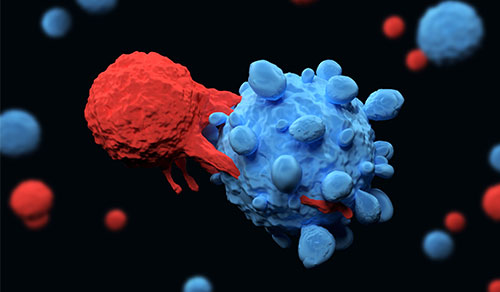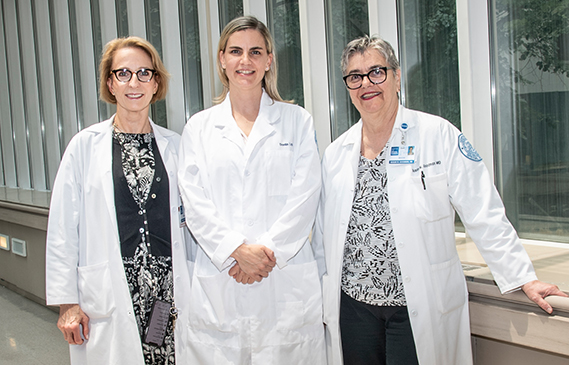Dynamic Partnerships Heighten Research in Rheumatoid Arthritis
In 2014, Hospital for Special Surgery was selected as a research site to participate in the newly launched Accelerating Medicines Partnership® (AMP®) initiative, a public-private endeavor with the NIH, FDA, and other organizations to develop productive models of new diagnostics and treatments for a number of diseases, including rheumatoid arthritis and systemic lupus erythematosus. Through the AMP RA/SLE Network, the research sites work collaboratively to define shared and disease-specific biological pathways in order to identify relevant drug targets for the treatment of rheumatoid arthritis, lupus, and related autoimmune diseases.
In that year, the AMP HSS Clinical Research Site was led by Vivian P. Bykerk, MD, Director, Inflammatory Arthritis Center; Lionel B. Ivashkiv, MD, Chief Scientific Officer; and Alessandra B. Pernis, MD, Senior Scientist, at HSS; along with Robert B. Darnell, MD, PhD, Founding Director, New York Genome Center. The program continues today under the leadership of Dr. Bykerk, rheumatologist Susan M. Goodman, MD, and Laura Donlin, PhD, an immunologist with dual appointments at the HSS Research Institute and Weill Cornell Medicine Physiology Biophysics and Systems Biology (PBSB) program.
Dr. Vivian Bykerk, Dr. Laura Donlin, and Dr. Susan Goodman
The HSS Clinical Research Site focuses specifically on RA and, since its inception, clinicians and scientists have pursued investigations of molecular processes that are responsible for flares, stiffness, and other clinical manifestations of the disease. “The NIH brought us together as a collaborative team to develop standard operating procedures for performing this type of research, which had not been done previously anywhere in the world,” says Dr. Bykerk, who is also a Professor of Medicine at Weill Cornell Medicine. “It enabled clinicians to work with scientists who have access to the latest and greatest of technologies with the capability of sequencing single cells and characterizing molecular phenotypes. Research programs quickly developed from having no one studying synovial tissue to establishing biopsy programs facilitating clinical studies in this area.”
“The program that we had been building in translational medicine at HSS received a huge boost from the AMP program,” adds Dr. Goodman, a Professor of Clinical Medicine at Weill Cornell Medicine. “The whole idea of a translational program in rheumatoid arthritis is that it provides us with a mechanism to come together with our basic scientists to try to understand what we as clinicians have not yet been able to get to the bottom of. Over the years improvements in drugs and treatment regimens have been enormous, but there is a persistent 20 to 30 percent of patients for whom we can’t figure out why they’re not getting better. The ability to study this in the context of RA immunopathology with gene expression analyses and other advanced tools not usually available on the clinical research side is extraordinarily powerful.”
“From these collaborative studies, we are learning new ways to ask clinical questions,” continues Dr. Goodman. “We are closing in on which cells at the molecular level are mediating some of the more severe reactions and attaining a better sense of the clinical features presenting in these patients. This is providing a multifaceted picture that enables us to identify patients we need to target more aggressively. We hope to one day be in a position where we can say, ‘In your case, we can target this cell and structure your treatment regimen around that.’”
“We know relatively little about the human immune system in comparison to what we’ve learned in mouse models,” says Dr. Donlin, an Assistant Professor of Immunology in Medicine at Weill Cornell Medicine. “I came to HSS from Rockefeller to transition my efforts from animal studies to human studies. Today’s high-dimensional technologies, including single cell RNA sequencing combined with mass cytometry, allow us to examine the complexity of the human immune system, providing much greater detail than we have ever been able to achieve in the past.”
“Between the time a potential target is identified and Phase 3 of clinical trials are conducted, 95 percent of these drug targets don’t pan out,” continues Dr. Donlin. “One of the goals of AMP is to find the correct molecules and pathways in the human system and then go back and create a more disease relevant model in an animal system.”
Defining Clinical Characteristics in the Context of Basic Pathophysiology
Now in its seventh year, AMP has enabled HSS and the other Clinical Research Sites to evolve from proof-of-concept studies to all phases of clinical trials in rheumatoid arthritis. Availability of deeper clinical, histological, and molecular data is fostering important insights in RA pathogenesis and helping to identify novel clinical targets. Following are a number of projects underway or recently completed by the HSS team and their AMP Consortium colleagues.
Stiffness: Quantifying This Classic Symptom
Dr. Bykerk and Dr. Goodman, working with Dr. Donlin and Dana E. Orange, MD, a rheumatologist with dual appointments at HSS and The Rockefeller University, have been pursuing research to understand the clinical characteristics of stiffness. “Stiffness is one of those classic symptoms of RA, but nobody really understands it or knows how to measure it,” says Dr. Goodman. “Uncovering its etiology would help us separate out stiffness from other characteristics of RA and put us in a much better position to treat it effectively.”
The research team, led by Dr. Orange, undertook a study to determine the possibility of synovium involvement in morning stiffness through data collected on 176 patients with RA undergoing arthroplasty. Their findings, reported in the October 15, 2019 issue of Arthritis & Rheumatology, showed that the presence of neutrophils and fibrin in RA synovial tissue were significantly associated with patient-reported morning stiffness lasting at least one hour, although none of the synovial features examined were associated with severity. The authors concluded, “In RA, prolonged morning stiffness may be related to impaired fibrinolysis of neutrophil-enmeshed fibrin deposits along the synovial membrane…and that morning stiffness severity and duration may reflect distinct pathophysiologic phenomena.”
Read more:
Orange DE, Blachere NE, DiCarlo EF, Mirza S, Pannellini T, Jiang CS, Frank MO, Parveen S, Figgie MP, Gravallese EM, Bykerk VP, Orbai AM, Mackie SL, Goodman SM. Rheumatoid Arthritis Morning Stiffness Is Associated With Synovial Fibrin and Neutrophils. Arthritis & Rheumatology. 2020 Apr;72(4):557-564. 10.1002/art.41141.
A New Cell May Predict Flare in RA
Despite the prevalence of flares, the molecular events leading to disease exacerbations remain unknown. To address this gap, Dr. Orange and her colleagues at several research centers developed a study to uncover the factors that trigger an autoimmune flare. The team established a clinical and technical protocol for repeated home blood collection that would provide high quality RNA in large quantities for longitudinal RNA sequencing. Their analysis of RA flares revealed preinflammatory mesenchymal (PRIME) cells in the blood that shared features of inflammatory synovial fibroblasts. In addition, their findings suggested a model in which PRIME cells become activated by B cells in the weeks before a flare and subsequently migrate from the blood into the synovium.
“Overall, we think that PRIME cells may act as gatekeepers and play a critical role in RA disease processes,” says Dr. Orange, who served as lead author on the study. “If that’s true, it opens up a whole new field of research that may one day lead to new treatments that can shut down flares before they happen.”
Read more:
Orange DE, Yao V, Sawicka K, Fak J, Frank MO, Parveen S, Blachere NE, Hale C, Zhang F, Raychaudhuri S, Troyanskaya OG, Darnell RB. RNA Identification of PRIME Cells Predicting Rheumatoid Arthritis Flares. The New England Journal of Medicine. 2020 Jul 16;383(3):218-228.
Molecular Discoveries, Clinical Developments
“Our current clinical reality is not satisfactory,” says Dr. Bykerk. “We rarely achieve full, sustained remission. AMP is showing us that clinical phenomena can be evaluated in the context of molecular features and inform us on treatment alternatives, and AMP Phase 2 findings are already suggesting possible new clinical targets. New basic findings in cell populations and subtypes in RA synovial tissue are making it possible to link elements such as clinical variation in disease activity, serostatus, pathotype, medication exposure, and disease activity following treatment and changes in treatment.”
Studies by HSS researchers and their AMP colleagues have demonstrated that newly discovered subsets of cells found in joint tissue among patients with RA and how they interact could potentially explain why only certain individuals respond to current treatments. “Right now, the standard approach for treating patients is trial and error,” notes Dr. Donlin. “Sometimes it can take a year or more to find an effective treatment. Meanwhile, the disease progresses and, in some cases, irreversible damage results.”
In a multicenter study, published in Nature Immunology, Dr. Donlin and her colleagues collaborated to develop a comprehensive map of cells in RA joint tissue using sequencing technologies. The researchers found 18 unique cell populations in synovial tissue among 36 patients with RA. Additionally, several of these cell types were present in higher amounts in subjects with RA – including a fibroblast subset that is a major producer of interleukin-6 – as compared to control groups of patients with osteoarthritis. Furthermore, the research team became the first to identify a subset of autoimmune-associated B cells in synovial tissue, also found in high quantities among patients with RA.
“Cutting-edge single-cell RNA sequencing technology allowed us to see the complexity of cell populations in RA tissue for the first time,” says Dr. Donlin. “By identifying these 18 new cell types in RA scenarios, we can now all study how these cell types interact with each other, how differences in the ratios of these cells can impact a patient’s disease, and how we can improve how we target each individual’s disease. The Nature immunology AMP publication serves as a resource paper for the entire research community.”
In a second study, published in Science Translational Medicine, Dr. Donlin and her colleagues honed in on one subset in particular of those 18 subtypes – HBEGF+ inflammatory macrophages. “We were able to really go deep down into the mechanism of how these macrophages are generated, how they then impact pathologies interacting with other cell types, and how medications can transform their phenotypes for good or for bad.”
Illustration of a macrophage, a type of immune cell that plays a key role in rheumatoid arthritis
Testing whether RA medications would enable these macrophages to stop the disease at the cellular level, the research team found that while NSAIDs were successful at significantly altering these macrophages, they did not prevent TNF responses. “The capacity to marry data sets generated here at HSS with the AMP dataset enabled us to confirm that the phenotypes we were studying are very relevant and are found in large quantities in the joint tissue of RA patients,” says Dr. Donlin.
The HSS researchers are now using primary patient tissues to test both current FDA approved medications and experimental drugs, with the goal of bringing them to early phase clinical trials. One such drug, AG-1478, an epidermal growth factor receptor inhibitor that is an experimental drug developed for cancer, was able to reverse the activity of HBEGF+ inflammatory macrophages.
“While the drug used in these experiments may be too toxic to use in patients with RA, the results demonstrated that it is possible to target activity of these cells and set the stage for developing other drugs that could address the same mechanism but with more specificity and that have the potential for treatment by methods other than suppressing the immune system,” explains Dr. Donlin. “We hope that through a better understanding of the cell populations in individual patients we can provide a means by which we can treat them with precision medicine strategies at the earliest stages of disease.”
Read more:
Lakhanpal A, Smith MH, Donlin LT. Rheumatology in the era of precision medicine: Synovial tissue molecular patterns and treatment response in rheumatoid arthritis. Current Opinion in Rheumatology. 2021 Jan;33(1):58-63.
Zhang F, Wei K, Slowikowski K, Fonseka CY, Rao DA, Kelly S, Goodman SM…Bykerk VP, Donlin LT, Anolik JH, Brenner MB, Raychaudhuri S. Defining inflammatory cell states in rheumatoid arthritis joint synovial tissues by integrating single-cell transcriptomics and mass cytometry. Nature Immunology. 2019 Jul;20(7):928-942.
Kuo D, Ding J, Cohn IS, Zhang F, Wei K, Rao DA, Rozo C, Sokhi UK, Shanaj S, Oliver DJ, Echeverria AP, DiCarlo EF, Brenner MB, Bykerk VP, Goodman SM, Raychaudhuri S, Rätsch G, Ivashkiv LB, Donlin LT. HBEGF+ macrophages in rheumatoid arthritis induce fibroblast invasiveness. Science Translational Medicine. 2019 May 8;11(491):eaau8587.
Related Publications









